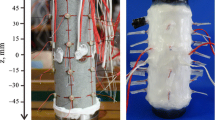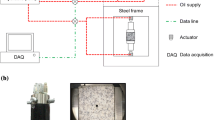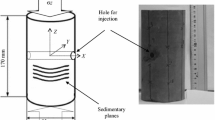Abstract
In the present work, we investigate the mechanical weakening and deformation induced by water on a microporous carbonate rock, the Obourg Chalk from Mons Basin (Belgium), through conventional triaxial tests and injection tests. The injection tests were conducted by waterflooding critically loaded rock samples, initially in dry condition, in a way to minimize the variations in the effective pressures. Furthermore, the samples were instrumented with P-wave piezoelectric transducers to provide active ultrasonic monitoring while injecting. The results show a significant reduction in the mechanical strength of this chalk. Analysis of the mechanical tests and the associated deformation allows us to describe the mechanical behavior as a function of the confining pressure, which draws a brittle-ductile transition spanning from low to high confining pressure. The injection tests, moreover, revealed that the amount of water injected before triggering mechanical instability decreases exponentially with respect to the applied differential stress on the rock sample. The data, therefore, suggest that the failure might be controlled by a mechanical coupling between the water-invaded zone and the dry one. Since water-weakening plays an important role in several fields like oil industry, through secondary and tertiary recovery of hydrocarbons, Enhanced Geothermal Systems (EGS), as well as in the mechanical stability of underground cavities, the outcome of this work is of primary importance in mitigating any kind of problems related to these operations.



(Modified after Wild et al. 2015)

















Similar content being viewed by others
Availability of Data and Materials
The presented data collected through experiments conducted by the authors are stored in the database of Cergy Paris Université and can be made available upon request.
Abbreviations
- AIC:
-
Akaike Information Criterion
- ATC:
-
Autonomous Triaxial Cell™
- CSIRO:
-
Geophysics and Geomechanics lab of the Commonwealth Scientific and Industrial Research Organisation
- CYU:
-
CY Cergy-Paris Université
- GDS:
-
Global Digital Systems Instruments Ltd™
- GEO2FRI2SK:
-
GEOphysical and GEOtechnical impact of Fluid–Rock Interaction for RISK assessment in chalk formation
- IFPEN:
-
Institut Français du Pétrole et des Energies Nouvelles
- OB:
-
Obourg chalk
- PZT:
-
Lead zirconate titanate piezoelectric transducer
- RISSC:
-
Risque Sous-Sol engendrés par les terraines sous-Cavés
- SML:
-
Saint-Maximin Limestone
- VIS:
-
Virtual infinite stiffness
- ϕ :
-
Porosity
- m :
-
Mass
- ρ :
-
Density
- σ 1 :
-
Maximum principal stress
- σ 2 :
-
Intermediate principal stress
- σ 3 :
-
Minimum principal stress
- Q :
-
Differential stress
- P C :
-
Confining pressure
- P P :
-
Pore pressure
- P C_eff :
-
Effective confining pressure
- P :
-
Effective mean stress
- ε :
-
Strain
- \(\dot{\varepsilon }\) :
-
Creep strain rate
- L :
-
Sample length
- ε v :
-
Volumetric strain
- ε a :
-
Axial strain
- ε r :
-
Radial strain
- V P :
-
P-wave velocity
- K :
-
Bulk modulus
- α :
-
Biot’s coefficient
- σ*:
-
Normalized stress
- σ C :
-
Differential stress for injection test
- σ P :
-
Triaxial compressive strength
- σ F :
-
Frictional strength
- γ :
-
Surface energy
- γʹ:
-
Surface energy in water-saturated condition
References
Ashby MF, Sammis CG (1990) The damage mechanics of brittle solids in compression. Pure Appli Geophys PAGEOPH. https://doi.org/10.1007/BF00878002
Batiste SN, Alshibli KA, Sture S, Lankton M (2004) Shear band characterization of triaxial sand specimens using computed tomography. Geotech Test J. https://doi.org/10.1520/gtj12080
Baud P, Meredith PG (1997) Damage accumulation during triaxial creep of Darley Dale sandstone from pore volumometry and acoustic emission. Int J Rock Mech Mining Sci Geomech Abstr. https://doi.org/10.1016/S1365-1609(97)00060-9
Baud P, Zhu W, Wong T (2000) Failure mode and weakening effect of water on sandstone. J Geophys Res Solid Earth. https://doi.org/10.1029/2000jb900087
Baud P, Klein E, Wong T, fong, (2004) Compaction localization in porous sandstones: spatial evolution of damage and acoustic emission activity. J Struct Geol. https://doi.org/10.1016/j.jsg.2003.09.002
Baud P, Vinciguerra S, David C et al (2009) Compaction and failure in high porosity carbonates: mechanical data and microstructural observations. Pure Appl Geophys. https://doi.org/10.1007/s00024-009-0493-2
Baud P, Schubnel A, Heap M, Rolland A (2017) Inelastic compaction in high-porosity limestone monitored using acoustic emissions. J Geophys Res Solid Earth. https://doi.org/10.1002/2017JB014627
Brantut N, Heap MJ, Meredith PG, Baud P (2013) Time-dependent cracking and brittle creep in crustal rocks: a review. J Struct Geol 52:17–43
Cotterell B, Rice JR (1980) Slightly curved or kinked cracks. Int J Fract 16:155–169. https://doi.org/10.1007/BF00012619
Dautriat J, Sarout J, David C et al (2016) Remote monitoring of the mechanical instability induced by fluid substitution and water weakening in the laboratory. Phys Earth Planet Inter. https://doi.org/10.1016/j.pepi.2016.06.011
David C, Bertauld D, Dautriat J et al (2015a) Detection of moving capillary front in porous rocks using X-ray and ultrasonic methods. Front Phys. https://doi.org/10.3389/fphy.2015.00053
David C, Dautriat J, Sarout J et al (2015b) Mechanical instability induced by water weakening in laboratory fluid injection tests. J Geophys Res Solid Earth. https://doi.org/10.1002/2015JB011894
Delage P, Cui YJ, Schroeder C (1996) Subsidence and capillary effects in chalks. In: ISRM International Symposium—EUROCK 1996
Delle Piane C, Sarout J (2016) Effects of water and supercritical CO2 on the mechanical and elastic properties of Berea sandstone. Int J Greenhouse Gas Control. https://doi.org/10.1016/j.ijggc.2016.06.001
Desrues J, Chambon R, Mokni M, Mazerolle F (1996) Void ratio evolution inside shear bands in triaxial sand specimens studied by computed tomography. Geotechnique. https://doi.org/10.1680/geot.1996.46.3.529
Dupuis C, Vandycke S (1989) Tectonique et karstification profonde : un modèle de subsidence original pour le Bassin de Mons. Annales de la Société géologique de Belgique
Fabricius IL (2007) Chalk: composition, diagenesis and physical properties. Bull Geol Soc Denmark 55:97–128
Faÿ-Gomord O, Soete J, Katika K et al (2016) New insight into the microtexture of chalks from NMR analysis. Mar Pet Geol. https://doi.org/10.1016/j.marpetgeo.2016.04.019
Faÿ-Gomord O, Soete J, Davy CA et al (2017) Tight chalk: Characterization of the 3D pore network by FIB-SEM, towards the understanding of fluid transport. J Petrol Sci Eng. https://doi.org/10.1016/j.petrol.2017.05.005
Han B, Xie SY, Shao JF (2016) Experimental investigation on mechanical behaviour and permeability evolution of a porous limestone under compression. Rock Mech Rock Eng. https://doi.org/10.1007/s00603-016-1000-6
Heap MJ, Baud P, Meredith PG et al (2009) Time-dependent brittle creep in darley dale sandstone. J Geophys Res Solid Earth. https://doi.org/10.1029/2008JB006212
Heggheim T, Madland MV, Risnes R, Austad T (2005) A chemical induced enhanced weakening of chalk by seawater. J Petrol Sci Eng. https://doi.org/10.1016/j.petrol.2004.12.001
Homand S, Shao JF (2000) Mechanical behaviour of a porous chalk and water/chalk interaction, part I: experimental study. Oil Gas Sci Technol. https://doi.org/10.2516/ogst:2000044
Jaeger J, Cook NG, Zimmerman R (2007) Fundamentals of Rock Mechanics(4E). John Wiley & Sons, Hoboken
Kranz RL, Scholz CH (1977) Critical dilatant volume of rocks at the onset of Tertiary creep. J Geophys Res. https://doi.org/10.1029/jb082i030p04893
Lai P, Krevor S (2014) Pore scale heterogeneity in the mineral distribution and surface area of Berea sandstone. In: Energy Procedia
Leonard M, Kennett BLN (1999) Multi-component autoregressive techniques for the analysis of seismograms. Phys Earth Planet Interiors 113(1–4):247–263
Madland MV, Hiorth A, Omdal E et al (2011) Chemical alterations induced by rock-fluid interactions when injecting brines in high porosity chalks. Transp Porous Media. https://doi.org/10.1007/s11242-010-9708-3
Mavko G, Mukerji T, Dvorkin J (2009) The rock physics handbook. Cambridge University Press, Cambridge
Nicolas A, Fortin J, Regnet JB et al (2016) Brittle and semi-brittle behaviours of a carbonate rock: Influence of water and temperature. Geophys J Int. https://doi.org/10.1093/gji/ggw154
Risnes R, Haghighi H, Korsnes RI, Natvik O (2003) Chalk-fluid interactions with glycol and brines. Tectonophysics. https://doi.org/10.1016/S0040-1951(03)00187-2
Risnes R, Madland MV, Hole M, Kwabiah NK (2005) Water weakening of chalk—mechanical effects of water-glycol mixtures. J Petrol Sci Eng. https://doi.org/10.1016/j.petrol.2005.04.004
Robaszynski F, Dhondt AV, Jagt JWM (2002) Cretaceous lithostratigraphic units (Belgium). Geol Belgica. https://doi.org/10.20341/gb.2014.049
Røyne A, Bisschop J, Dysthe DK (2011) Experimental investigation of surface energy and subcritical crack growth in calcite. J Geophys Res Solid Earth. https://doi.org/10.1029/2010JB008033
Røyne A, Dalby KN, Hassenkam T (2015) Repulsive hydration forces between calcite surfaces and their effect on the brittle strength of calcite-bearing rocks. Geophys Res Lett. https://doi.org/10.1002/2015GL064365
Sarout J, Esteban L, Piane CD et al (2014) Elastic anisotropy of Opalinus Clay under variable saturation and triaxial stress. Geophys J Int. https://doi.org/10.1093/gji/ggu231
Sarout J, Cazes E, Delle Piane C et al (2017) Stress-dependent permeability and wave dispersion in tight cracked rocks: experimental validation of simple effective medium models. J Geophys Res Solid Earth. https://doi.org/10.1002/2017JB014147
Schroeder C, Shao J (1996) Plastic deformation and capillary effects in chalks. In: Fifth North Sea chalk symposium SPE/ISRM programme committee, Reims, France
Stanchits S, Mayr S, Shapiro S, Dresen G (2011) Fracturing of porous rock induced by fluid injection. Tectonophysics. https://doi.org/10.1016/j.tecto.2010.09.022
Vajdova V, Baud P, Wong TF (2004) Compaction, dilatancy, and failure in porous carbonate rocks. J Geophys Res Solid Earth. https://doi.org/10.1029/2003JB002508
Vandycke S (2002) Palaeostress records in Cretaceous formations in NW Europe: extensional and strike-slip events in relationships with Cretaceous-Tertiary inversion tectonics. Tectonophysics. https://doi.org/10.1016/S0040-1951(02)00365-7
Vandycke S, Bergerat F, Dupuis C (1991) Meso-cenozoic faulting and inferred palaeostresses in the Mons Basin, Belgium. Tectonophysics. https://doi.org/10.1016/0040-1951(91)90103-Y
Vinciguerra S, Trovato C, Meredith PG et al (2006) Understanding the seismic velocity structure of Campi Flegrei caldera (Italy): From the laboratory to the field scale. Pure Appl Geophys 163:2205–2221
Voake T, Nermoen A, Ravnås C et al (2019) Influence of temperature cycling and pore fluid on tensile strength of chalk. J Rock Mech Geotech Eng. https://doi.org/10.1016/j.jrmge.2018.12.004
Wild KM, Amann F, Martin CD, Wassermann J, David C, Barla M (2015) Dilatancy of clay shales and its impact on pore pressure evolution and effective stress for different triaxial stress paths. In: 49th US Rock Mechanics/Geomechanics Symposium. American Rock Mechanics Association
Wong TF, Baud P (2012) The brittle-ductile transition in porous rock: a review. J Struct Geol 44:25–53
Wong T, David C, Zhu W (1997) The transition from brittle faulting to cataclastic flow in porous sandstones: mechanical deformation. J Geophys Res Solid Earth. https://doi.org/10.1029/96jb03281
Xie SY, Shao JF, Xu WY (2011) Influences of chemical degradation on mechanical behaviour of a limestone. Int J Rock Mech Min Sci. https://doi.org/10.1016/j.ijrmms.2011.04.015
Zhang J, Wong T-F, Davis DM (1990a) Micromechanics of pressure-induced grain crushing in porous rocks. J Geophys Res. https://doi.org/10.1029/jb095ib01p00341
Zhang J, Wong TF, Yanagidani T, Davis DM (1990b) Pressure-induced microcracking and grain crushing in berea and boise sandstones: acoustic emission and quantitative microscopy measurements. Mech Mater. https://doi.org/10.1016/0167-6636(90)90026-C
Acknowledgements
We thank Nicolas Gland and Elisabeth Rosenberg (IFPEN Rueil-Mailmaison) for their fruitful discussions about this work; Damien Bury (Université de Mons) for his help in sampling Obourg chalk; Roua Al Houmaissi for the work conducted during her master internship at CYU and David Nguyen, Ludwig Monmusson, Shane Kager (CSIRO) for their precious help in testing the material of this work.
Funding
This work has been supported by the Doctoral School of the Cergy Paris Université and by the GEO2FRI2SK project granted by the Paris-Seine Initiative. The authors also acknowledge the European Regional Development Fund (through the Interreg V FWVl programme) and Wallonia for funding the RISSC project in which this study is included.
Author information
Authors and Affiliations
Corresponding author
Ethics declarations
Conflict of Interest
The authors declare no conflict of interests.
Additional information
Publisher's Note
Springer Nature remains neutral with regard to jurisdictional claims in published maps and institutional affiliations.
Rights and permissions
About this article
Cite this article
Geremia, D., David, C., Descamps, F. et al. Water-Induced Damage in Microporous Carbonate Rock by Low-Pressure Injection Test. Rock Mech Rock Eng 54, 5185–5206 (2021). https://doi.org/10.1007/s00603-021-02411-4
Received:
Accepted:
Published:
Issue Date:
DOI: https://doi.org/10.1007/s00603-021-02411-4




